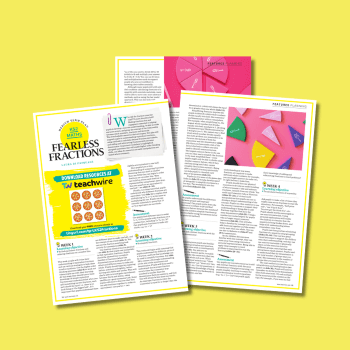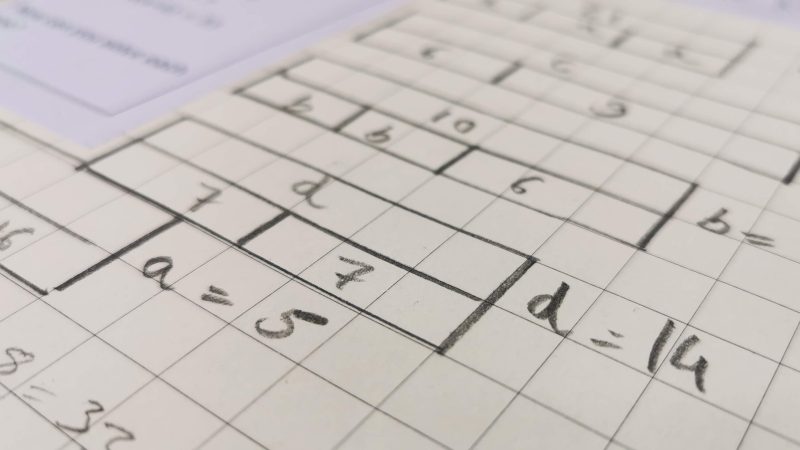Encourage Young Mathematicians To Think Flexibly About Their Approach To Unfamiliar Problems

Give your pupils a mental agility workout, says Mike Askew

- by Mike Askew

Which of these two calculations do you think is harder: 125.48 – 72.3, or 4 – 1.15? Your answer probably depends on how you think pupils are expected to work out the answer. If your expectation is that these numbers mean working with the column algorithm, then the first is probably marginally easier: the decimal point has been provided which helps in lining up the digits to set up the column method. Lining up the digits is not quite as obvious with the second: you have to know that you can write 4 as 4.00 and then set up the columns. If, however, you believe that calculating carries a degree of choice over the method depending on the numbers involved, then you might expect the second example to be easier, as a pupil might say to herself, ‘Well, adding 0.85 to 1.15 will bring it up to two, another two to four, so the answer is 2.85.’ In contrast, the first sum is less amenable to such a mental method, so the column method may be more sensible. However, given the number of digits, a slip-up is perhaps more likely. Both calculations were on the 2016 KS2 arithmetic paper, and the empirical evidence is that the first example was the easier, with a 79% success rate, compared to 64% for the other. Interesting as it is to focus on the numbers of pupils getting correct answers, it is also informative to look at some of the figures behind the success scores. For instance, the numbers of pupils attempting each question were 99% and 97% respectively.
That means 33% – a third – of Y6 pupils attempted the second sum but got it wrong. We don’t know what they showed on their papers – many perhaps simply wrote down an incorrect answer – but I suspect that many showed an attempt to carry out a column calculation that went wrong somewhere.
(On that note, if you have examples of what your pupils did that you could share, I would love to see them.) Also of interest is the number of pupils on free school meals (FSM) attempting and succeeding on each question. For the first sum, 98% of FSM pupils attempted the question, comparing favourably with 99% of NFSM (no free school meals). In terms of success, 74% of FSM pupils answered the question correctly, 7% fewer than the 81% of NFSM pupils getting it right.
For the second example, the numbers of FSM pupils and NFSM attempting the question are again similar: 96% and 98% respectively. But now the gap in success is more marked: only 54% of FMS pupils were successful compared to 69% of NFSM – a 15% gap in attainment is concerning.
Key questions we need to encourage learners to ask themselves before carrying out a calculation are, ‘Have I seen anything that looks like this before?’ and ‘Does that help me?’, rather than simply thinking, ‘Oh, two decimal places, that means a column calculation’. It is also helpful to ask when a calculation might be carried out. What might the success rate on 4 – 1.15 have been if it had been couched in something like: Sam went out with £4 and spent £1.15 on a magazine. How much did Sam have left to spend?
Key, critical and difficult points
The language that I use here of ‘key’, ‘critical’ and ‘difficult’ points comes from what teachers in Shanghai think about when designing lessons.
- The key point is the conceptual heart of the lesson, the ‘big idea’ that they expect all pupils to encounter during the lesson.
- The difficult point is the cognitive challenge that pupils are going to need to engage with before they grasp fully the key point.
- The critical point focus on the sort of question(s) that pupils need to engage to help them overcome the challenge of the difficult point and securely and confidently understand the key point.
Mike Askew is adjunct professor of education at Monash University, Melbourne. A former primary teacher, he now researches, speaks and writes on teaching and learning mathematics. Find him at mikeaskew.net.
If learners are to be confident in tackling calculations like 4 – 1.15 mentally, it is helpful to think about the ‘pieces’ of knowledge that need to be in place to help them do this. While it is accepted that pupils need to be able to rapidly recall number bonds to ten and then to 20, I suggest that there are other addition and subtraction ‘bonds’ that it helps to be able to rapidly recall, as they form a sound foundation for mental strategies. These include:
- Bonds of multiples of ten that sum to 100: 10 + 90, 20 + 80, 50 + 50 etc.
- Bonds to multiples of five that sum to 100: the above bonds and the ones ‘in between’, such as 5 + 95, 15 + 85, 45 + 65 etc.
- Bonds of multiples of 100 that sum to 1000: 100 + 900, 200 + 800, 500 + 500 etc.
- Bonds to multiples of 50 that sum to 1000: the above bonds and the ones ‘in between’, such as 50 + 950, 150 + 850, 450 + 650 etc.
| 35 + 65 | 55 + 45 | 100 – 15 |
| 350 + 650 | 550 + 450 | 1000 – 150 |
| 3.5 + 6.5 | 5.50 + 4.5 | 10 – 1.15 |
Strategic thinking
Key questions we need to encourage learners to ask themselves before carrying out a calculation are, ‘Have I seen anything that looks like this before?’ and ‘Does that help me?’, rather than simply thinking, ‘Oh, two decimal places, that means a column calculation’. It is also helpful to ask when a calculation might be carried out. What might the success rate on 4 – 1.15 have been if it had been couched in something like: Sam went out with £4 and spent £1.15 on a magazine. How much did Sam have left to spend?
Key, critical and difficult points
The language that I use here of ‘key’, ‘critical’ and ‘difficult’ points comes from what teachers in Shanghai think about when designing lessons.
- The key point is the conceptual heart of the lesson, the ‘big idea’ that they expect all pupils to encounter during the lesson.
- The difficult point is the cognitive challenge that pupils are going to need to engage with before they grasp fully the key point.
- The critical point focus on the sort of question(s) that pupils need to engage to help them overcome the challenge of the difficult point and securely and confidently understand the key point.
Mike Askew is adjunct professor of education at Monash University, Melbourne. A former primary teacher, he now researches, speaks and writes on teaching and learning mathematics. Find him at mikeaskew.net.
Y2 pupils, for example, are expected to mentally add and subtract numbers that include a two-digit number and ones, with progress in Y3 meaning moving on to adding or subtracting either tens or hundreds to or from a three-digit number. The Y4 and 5 requirements both just talk of ‘increasingly larger numbers’. We also need to work on mental strategies with increasingly smaller numbers.
Building blocks
If learners are to be confident in tackling calculations like 4 – 1.15 mentally, it is helpful to think about the ‘pieces’ of knowledge that need to be in place to help them do this. While it is accepted that pupils need to be able to rapidly recall number bonds to ten and then to 20, I suggest that there are other addition and subtraction ‘bonds’ that it helps to be able to rapidly recall, as they form a sound foundation for mental strategies. These include:
- Bonds of multiples of ten that sum to 100: 10 + 90, 20 + 80, 50 + 50 etc.
- Bonds to multiples of five that sum to 100: the above bonds and the ones ‘in between’, such as 5 + 95, 15 + 85, 45 + 65 etc.
- Bonds of multiples of 100 that sum to 1000: 100 + 900, 200 + 800, 500 + 500 etc.
- Bonds to multiples of 50 that sum to 1000: the above bonds and the ones ‘in between’, such as 50 + 950, 150 + 850, 450 + 650 etc.
| 35 + 65 | 55 + 45 | 100 – 15 |
| 350 + 650 | 550 + 450 | 1000 – 150 |
| 3.5 + 6.5 | 5.50 + 4.5 | 10 – 1.15 |
Strategic thinking
Key questions we need to encourage learners to ask themselves before carrying out a calculation are, ‘Have I seen anything that looks like this before?’ and ‘Does that help me?’, rather than simply thinking, ‘Oh, two decimal places, that means a column calculation’. It is also helpful to ask when a calculation might be carried out. What might the success rate on 4 – 1.15 have been if it had been couched in something like: Sam went out with £4 and spent £1.15 on a magazine. How much did Sam have left to spend?
Key, critical and difficult points
The language that I use here of ‘key’, ‘critical’ and ‘difficult’ points comes from what teachers in Shanghai think about when designing lessons.
- The key point is the conceptual heart of the lesson, the ‘big idea’ that they expect all pupils to encounter during the lesson.
- The difficult point is the cognitive challenge that pupils are going to need to engage with before they grasp fully the key point.
- The critical point focus on the sort of question(s) that pupils need to engage to help them overcome the challenge of the difficult point and securely and confidently understand the key point.
Mike Askew is adjunct professor of education at Monash University, Melbourne. A former primary teacher, he now researches, speaks and writes on teaching and learning mathematics. Find him at mikeaskew.net.
The second emphasises the connection with the previous whole number subtraction – although hundredths are being subtracted, this is essentially no different from subtracting whole numbers. Everything is now set up for 4 – 1.15, a discussion of how this relates to the calculations already done, what the answer is and whether the question is a difficult as it might first appear. Follow up practice calculations might include examples such as (working down the columns):
| 300 – 100 | 500 – 200 | 400 – 225 |
| 300 – 145 | 500 – 225 | 4 – 225/100 |
| 3 – 1.45 | 50 – 22.5 | 4.0 – 2.25 |
Going supersize
One of the challenges with the mathematics curriculum when set out as year level expectations, as we now have, is deciding what gets replaced over the years and what needs to continue between them. If they are to progress, a Y1 pupil who uses counters to solve simple problems needs to replace that with recall of some number bonds and the use of strategies to figure out answers that they cannot recall. But not everything later in the curriculum needs to replace earlier knowledge. Instead we can continue and build on previous understanding. A problem with the national curriculum is the implication that progression, particularly in mental calculation, is about working with larger numbers.
Y2 pupils, for example, are expected to mentally add and subtract numbers that include a two-digit number and ones, with progress in Y3 meaning moving on to adding or subtracting either tens or hundreds to or from a three-digit number. The Y4 and 5 requirements both just talk of ‘increasingly larger numbers’. We also need to work on mental strategies with increasingly smaller numbers.
Building blocks
If learners are to be confident in tackling calculations like 4 – 1.15 mentally, it is helpful to think about the ‘pieces’ of knowledge that need to be in place to help them do this. While it is accepted that pupils need to be able to rapidly recall number bonds to ten and then to 20, I suggest that there are other addition and subtraction ‘bonds’ that it helps to be able to rapidly recall, as they form a sound foundation for mental strategies. These include:
- Bonds of multiples of ten that sum to 100: 10 + 90, 20 + 80, 50 + 50 etc.
- Bonds to multiples of five that sum to 100: the above bonds and the ones ‘in between’, such as 5 + 95, 15 + 85, 45 + 65 etc.
- Bonds of multiples of 100 that sum to 1000: 100 + 900, 200 + 800, 500 + 500 etc.
- Bonds to multiples of 50 that sum to 1000: the above bonds and the ones ‘in between’, such as 50 + 950, 150 + 850, 450 + 650 etc.
| 35 + 65 | 55 + 45 | 100 – 15 |
| 350 + 650 | 550 + 450 | 1000 – 150 |
| 3.5 + 6.5 | 5.50 + 4.5 | 10 – 1.15 |
Strategic thinking
Key questions we need to encourage learners to ask themselves before carrying out a calculation are, ‘Have I seen anything that looks like this before?’ and ‘Does that help me?’, rather than simply thinking, ‘Oh, two decimal places, that means a column calculation’. It is also helpful to ask when a calculation might be carried out. What might the success rate on 4 – 1.15 have been if it had been couched in something like: Sam went out with £4 and spent £1.15 on a magazine. How much did Sam have left to spend?
Key, critical and difficult points
The language that I use here of ‘key’, ‘critical’ and ‘difficult’ points comes from what teachers in Shanghai think about when designing lessons.
- The key point is the conceptual heart of the lesson, the ‘big idea’ that they expect all pupils to encounter during the lesson.
- The difficult point is the cognitive challenge that pupils are going to need to engage with before they grasp fully the key point.
- The critical point focus on the sort of question(s) that pupils need to engage to help them overcome the challenge of the difficult point and securely and confidently understand the key point.
Mike Askew is adjunct professor of education at Monash University, Melbourne. A former primary teacher, he now researches, speaks and writes on teaching and learning mathematics. Find him at mikeaskew.net.
Again, it is difficult to know what might account for this difference, but if research findings are anything to go by, it is likely that children from less-well-off backgrounds made more use of a taught method rather than working mentally, due to differences in expectations of schooling and authority.
An eye for structure
In a classic piece of research, Ann Dowker of Oxford University asked professional mathematicians to estimate answers to a number of calculations. A key finding was that rather than use anything that looked like standard algorithms, the mathematicians were more likely to draw on their understanding of arithmetical properties and relationships between numbers, in particular making use of ‘known’ or ‘nicer’ numbers.
In other words, the mathematicians displayed flexibility in their approaches and what some writers refer to as an ‘eye for structure’ – looking at the relationship between the numbers involved in a calculation, not just at the operation set out. Regular readers of this column will know that I’m keen on what I call ‘reasoning chains’ to encourage pupils to look for relationships and structure, both between numbers in a calculation and among a connected chain of calculations.
I often construct these chains by taking an example like 4 – 1.15 and working back to create connected and increasingly simpler calculations, that when worked through in reverse order lead back up to the original calculation. Using this approach I came up with this chain for upper KS2:
400 – 100
400 – 115
400/100 – 115/100
4 – 1.15
- Is it OK to write a fraction like 400/100?
- How else could we write that number?
- Can we subtract hundredths from hundredths?
Four hundred hundredths minus one hundred and fifteen hundredths
Four hundred hundredths minus one hundred and fifteen hundredths.
The first emphasises that hundredths are being subtracted from hundredths, so although this subtraction is unusual, in subtracting like from like it is fine.The second emphasises the connection with the previous whole number subtraction – although hundredths are being subtracted, this is essentially no different from subtracting whole numbers. Everything is now set up for 4 – 1.15, a discussion of how this relates to the calculations already done, what the answer is and whether the question is a difficult as it might first appear. Follow up practice calculations might include examples such as (working down the columns):
| 300 – 100 | 500 – 200 | 400 – 225 |
| 300 – 145 | 500 – 225 | 4 – 225/100 |
| 3 – 1.45 | 50 – 22.5 | 4.0 – 2.25 |
Going supersize
One of the challenges with the mathematics curriculum when set out as year level expectations, as we now have, is deciding what gets replaced over the years and what needs to continue between them. If they are to progress, a Y1 pupil who uses counters to solve simple problems needs to replace that with recall of some number bonds and the use of strategies to figure out answers that they cannot recall. But not everything later in the curriculum needs to replace earlier knowledge. Instead we can continue and build on previous understanding. A problem with the national curriculum is the implication that progression, particularly in mental calculation, is about working with larger numbers.
Y2 pupils, for example, are expected to mentally add and subtract numbers that include a two-digit number and ones, with progress in Y3 meaning moving on to adding or subtracting either tens or hundreds to or from a three-digit number. The Y4 and 5 requirements both just talk of ‘increasingly larger numbers’. We also need to work on mental strategies with increasingly smaller numbers.
Building blocks
If learners are to be confident in tackling calculations like 4 – 1.15 mentally, it is helpful to think about the ‘pieces’ of knowledge that need to be in place to help them do this. While it is accepted that pupils need to be able to rapidly recall number bonds to ten and then to 20, I suggest that there are other addition and subtraction ‘bonds’ that it helps to be able to rapidly recall, as they form a sound foundation for mental strategies. These include:
- Bonds of multiples of ten that sum to 100: 10 + 90, 20 + 80, 50 + 50 etc.
- Bonds to multiples of five that sum to 100: the above bonds and the ones ‘in between’, such as 5 + 95, 15 + 85, 45 + 65 etc.
- Bonds of multiples of 100 that sum to 1000: 100 + 900, 200 + 800, 500 + 500 etc.
- Bonds to multiples of 50 that sum to 1000: the above bonds and the ones ‘in between’, such as 50 + 950, 150 + 850, 450 + 650 etc.
| 35 + 65 | 55 + 45 | 100 – 15 |
| 350 + 650 | 550 + 450 | 1000 – 150 |
| 3.5 + 6.5 | 5.50 + 4.5 | 10 – 1.15 |
Strategic thinking
Key questions we need to encourage learners to ask themselves before carrying out a calculation are, ‘Have I seen anything that looks like this before?’ and ‘Does that help me?’, rather than simply thinking, ‘Oh, two decimal places, that means a column calculation’. It is also helpful to ask when a calculation might be carried out. What might the success rate on 4 – 1.15 have been if it had been couched in something like: Sam went out with £4 and spent £1.15 on a magazine. How much did Sam have left to spend?
Key, critical and difficult points
The language that I use here of ‘key’, ‘critical’ and ‘difficult’ points comes from what teachers in Shanghai think about when designing lessons.
- The key point is the conceptual heart of the lesson, the ‘big idea’ that they expect all pupils to encounter during the lesson.
- The difficult point is the cognitive challenge that pupils are going to need to engage with before they grasp fully the key point.
- The critical point focus on the sort of question(s) that pupils need to engage to help them overcome the challenge of the difficult point and securely and confidently understand the key point.
Mike Askew is adjunct professor of education at Monash University, Melbourne. A former primary teacher, he now researches, speaks and writes on teaching and learning mathematics. Find him at mikeaskew.net.











